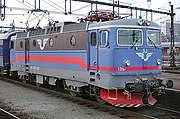Bo-Bo: Difference between revisions
m clean up using AWB |
Added information and a gellery of useful examples, sources will come too |
||
| Line 1: | Line 1: | ||
{{Unreferenced|date=December 2009}} |
{{Unreferenced|date=December 2009}} |
||
'''Bo-Bo''' is the [[UIC classification of locomotive axle arrangements|UIC]] indication of a wheel arrangement for railway vehicles with four axles in two individual [[bogies]], all driven by their own [[traction motor]]s. It is a common wheel arrangement for modern electric and diesel [[locomotive]]s, as well as driving cars in [[multiple unit]]s. |
|||
Most early electric locomotives shared commonalities with the steam engines of their time. These features included [[coupling rod|side rods]] and frame mounted driving axles with leading and trailing axles. The long rigid wheelbase and the leading and trailing axles reduced cornering stability and increased weight. |
|||
A '''Bo-Bo''' (UK usage) or '''Bo′Bo′''' ([[UIC notation]]) is a [[locomotive]] with two independent four-wheeled [[bogie]]s with all axles powered by individual [[traction motor]]s (cf [[AAR wheel arrangement#B-B|B-B]]). Bo-Bos are mostly suited to express passenger or medium-sized locomotives. |
|||
The Bo-Bo configuration allowed for higher cornering speeds due to the smaller rigid wheelbase. Furthermore it allowed better [[rail adhesion|adhesion]] because all the wheels were now powered. Due to the absence of frame mounted wheels no leading or trailing axles were necessary to aid cornering, reducing weight and maintenance requirements. |
|||
Typical Bo-Bo locomotives include [[DB Class 120]], [[FS Class E464]] and [[SJ Rc|SJ Class Rc]]. |
|||
Due to the advent of modern motors and electronics more power can be brought to the rail with only few axles. Modern electric locomotives can deliver up to 6400 kW on only four axles. For very heavy loads, especially in transportation of bulk goods, a single unit with this wheel arrangement tends to have too little adhesive weight to accelerate the train sufficiently fast without [[Locomotive wheelslip|wheelslip]]. |
|||
| ⚫ | |||
==Gallery== |
|||
{{gallery |
|||
|lines=6 |
|||
|File:Swiss Rail Re 4 4 I TEE 10033.jpg|The Swiss [[SBB Re 4/4 I|Re 4/4<sup>I</sup>]], built to negotiate curves at higher speeds, built in 1946 and weighing only 57 tons. |
|||
|File:BLS 164 1.jpg|The [[:de:BLS Re 4/4|BLS Re 4/4]], an early high performance Bo-Bo locomotive. Built from 1964 onwards, its 4980 kW is still significant for todays standards. |
|||
|File:186 111.JPG|The [[Bombardier TRAXX]] MS2, a multiple system multi-purpose locomotive built for the European railways. Significant numbers of the TRAXX family have been built for most European railways. |
|||
|File:Db-120142-00-c.jpg|The [[DB Class 120]], the first locomotive to use electronically controlled asynchronious three-phase motors to allow both high speed and high tractive effort. |
|||
|File:ES64U4 OEBB 1216 050 Hersbruck 30062007.JPG|The ÖBB 1216 050, currently (August 2012) the fastest electric locomotive ever built. It is a Siemens ES64U4, a member of the [[EuroSprinter]] family. |
|||
|File:Rc-lok.jpg|A Swedish [[SJ Rc|Rc]] locomotive. It was built in large numbers and exported to Austria and Norway. Also, it served as the basis for the American [[EMD AEM-7|AEM-7]] that replaced the famous [[PRR GG1|GG1]]. |
|||
}} |
|||
| ⚫ | |||
==See also== |
==See also== |
||
| Line 14: | Line 29: | ||
[[Category:Locomotives by wheel arrangement|Bo-Bo]] |
[[Category:Locomotives by wheel arrangement|Bo-Bo]] |
||
[[Category:Bo-Bo locomotives|*]] |
[[Category:Bo-Bo locomotives|*]] |
||
{{Loco-stub}} |
{{Loco-stub}} |
||
Revision as of 14:39, 14 August 2012
Bo-Bo is the UIC indication of a wheel arrangement for railway vehicles with four axles in two individual bogies, all driven by their own traction motors. It is a common wheel arrangement for modern electric and diesel locomotives, as well as driving cars in multiple units.
Most early electric locomotives shared commonalities with the steam engines of their time. These features included side rods and frame mounted driving axles with leading and trailing axles. The long rigid wheelbase and the leading and trailing axles reduced cornering stability and increased weight.
The Bo-Bo configuration allowed for higher cornering speeds due to the smaller rigid wheelbase. Furthermore it allowed better adhesion because all the wheels were now powered. Due to the absence of frame mounted wheels no leading or trailing axles were necessary to aid cornering, reducing weight and maintenance requirements.
Due to the advent of modern motors and electronics more power can be brought to the rail with only few axles. Modern electric locomotives can deliver up to 6400 kW on only four axles. For very heavy loads, especially in transportation of bulk goods, a single unit with this wheel arrangement tends to have too little adhesive weight to accelerate the train sufficiently fast without wheelslip.
In AAR notation a Bo-Bo is regarded as a B-B because the AAR system does not take traction motors into consideration, only powered axles. An AAR like notation is used in France too, making it hard to tell the B-B and Bo-Bo engines apart, both of which are common there.
Gallery
-
The Swiss Re 4/4I, built to negotiate curves at higher speeds, built in 1946 and weighing only 57 tons.
-
The BLS Re 4/4, an early high performance Bo-Bo locomotive. Built from 1964 onwards, its 4980 kW is still significant for todays standards.
-
The Bombardier TRAXX MS2, a multiple system multi-purpose locomotive built for the European railways. Significant numbers of the TRAXX family have been built for most European railways.
-
The DB Class 120, the first locomotive to use electronically controlled asynchronious three-phase motors to allow both high speed and high tractive effort.
-
The ÖBB 1216 050, currently (August 2012) the fastest electric locomotive ever built. It is a Siemens ES64U4, a member of the EuroSprinter family.






